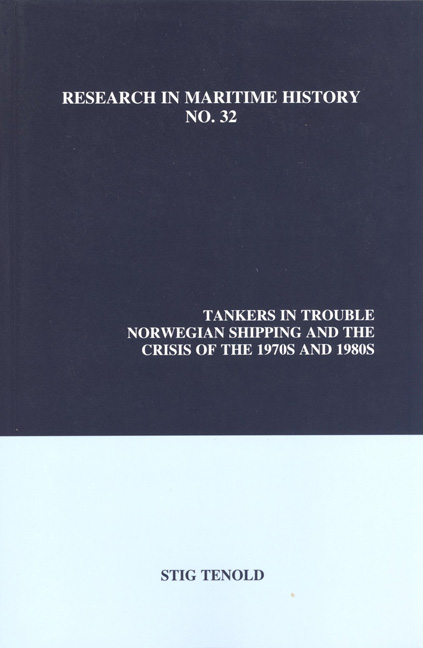Book contents
- Frontmatter
- Table of Contents
- List of Tables in the Text
- List of Illustrations
- Preface
- Chapter 1 Introduction
- Chapter 2 The Shipping Market after World War II
- Chapter 3 The Basis of the Tanker Crisis
- Chapter 4 The Contagion and Short-term Effects of the Crisis
- Chapter 5 Stage Two of the Crisis and the Long-term Changes
- Chapter 6 The Basis for the Crisis in Norwegian Shipping
- Chapter 7 Structural Transformations in Norwegian Shipping
- Chapter 8 The Fates of Four Norwegian Shipowners
- Chapter 9 Conclusion
- Appendices
- Bibliography: Select Bibliography
Preface
- Frontmatter
- Table of Contents
- List of Tables in the Text
- List of Illustrations
- Preface
- Chapter 1 Introduction
- Chapter 2 The Shipping Market after World War II
- Chapter 3 The Basis of the Tanker Crisis
- Chapter 4 The Contagion and Short-term Effects of the Crisis
- Chapter 5 Stage Two of the Crisis and the Long-term Changes
- Chapter 6 The Basis for the Crisis in Norwegian Shipping
- Chapter 7 Structural Transformations in Norwegian Shipping
- Chapter 8 The Fates of Four Norwegian Shipowners
- Chapter 9 Conclusion
- Appendices
- Bibliography: Select Bibliography
Summary
I first began to analyse the shipping crisis of the 1970s and the Norwegian predicament in a Master's thesis in economic history at the Norwegian School of Economics and Business Administration in the mid-1990s. As often happens, this early work generated more questions than answers.
There were two reasons for my interest in modern maritime history. First, as a boy growing up in Norway in the 1980s, shipping was very much a part of my daily life and cultural heritage. I lived some 300 metres from the headquarters of Hilmar Reksten, who - in his own words - was the world's largest independent tanker owner. Indeed, I delivered newspapers to his shipping company every morning. At the time, I did not know that the decreasing number of subscriptions reflected the decline of Reksten's empire. But as an economics student I subsequently learned about the principle of comparative advantage. The shipping sector is perhaps the best arena in economic history for the analysis of questions which relate to both the international and the Norwegian economies.
The second reason for my interest in maritime history is even more straightforward: Professor Helge W. Nordvik. Helge was renowned for his work in maritime history both in Norway and around the world, and his enthusiasm for shipping and shipping history was contagious. When I began my doctoral studies I asked Helge to be my supervisor, and many of the questions, hypotheses and approaches were formulated in close cooperation with him. Helge died suddenly in October 1998. My thesis, “The Shipping Crisis of the 1970s: Causes, Effects and Implications for Norwegian Shipping,” was defended in 2001. While I hope that it met Helge's high standards, it certainly was guided by one of his favourite mantras: “If it's worth doing, it's worth doing well.”
This book is a significantly restructured and updated version of the thesis. While the main arguments are unchanged, the structure of the analysis is new. In particular, I have tried to write the text so that the chapters can be read more or less independently. Consequently, someone with a particular interest in business history may go directly to chapter eight, while those with a strong dislike for statistical excursions can turn a blind eye to chapter seven without losing the thread of the argument.
- Type
- Chapter
- Information
- Tankers in TroubleNorwegian Shipping and the Crisis of the 1970s and 1980s, pp. xiv - xvPublisher: Liverpool University PressPrint publication year: 2006

